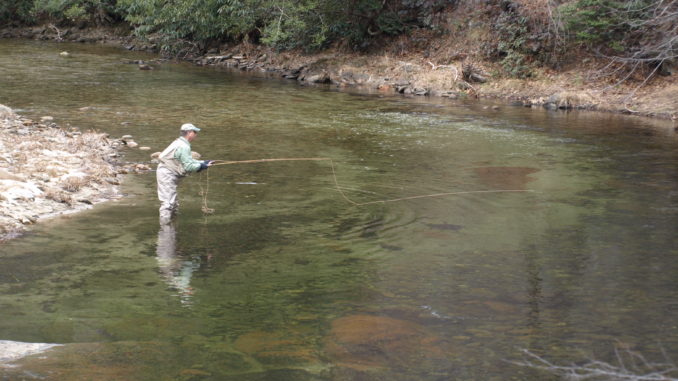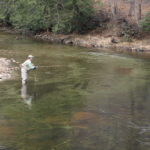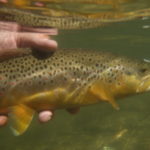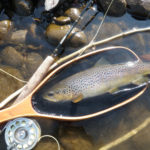
Top-drawer Caldwell County stream has pools, riffles, runs and pocket water
Wilson Creek is one of the jewels of North Carolina’s trout-fishing crown. Just off the Blue Ridge Parkway in Caldwell County, it is tucked in among the mountains of the Pisgah National Forest and supports, in various stretches, delayed-harvest and hatchery-supported waters, and several of its tributaries are designated as wild trout fisheries.
Wilson Creek has been designated as a wild and scenic river, as described in the Wild and Scenic Rivers Act of 1968. The Act seeks to preserve the qualities of such waterways through public and private, voluntary stewardship.
For most of its length, Wilson Creek tumbles gradually downhill, passing through classic series of pools, runs, and riffles, with pocket water common. A number of miles pass through an area called “The Gorge,” where the banks are high and steep. Though portions of the stream bank are private, and the rights of property owners should be respected, public access is excellent.
Whatever an angler’s preference for finding trout, such habitat abounds in Wilson Creek: pools, runs or riffles. When trout are stocked, they are near bridges or pools close to the road. Gradually, they disperse.
Squeak Smith, who has fished Wilson Creek for 25 years since retiring from the U.S. Air Force and moving to North Carolina, likes the delayed-harvest section.
“The four miles or so of river in the delayed-harvest section offer all water types, speeds and depths,” said Smith, who has been cited by Trout Unlimited for his contributions to cold-water fisheries. “However, as the fish are most often stocked in fairly large pools that are easily accessed from the road, that’s where I start. I tend to concentrate, particularly right after they are stocked, on finding a ‘group’ of fish in a pool and working them, moving along, finding another group and working them.”
Tim Wilhelm, a long-time leader of Trout Unlimited on the local and state level, also likes to seine Wilson Creek’s bigger pools, targeting fish he can see. He remembered one such pool.
“There were a bunch of fish in there — probably one of the places where they stocked,” he said. “In a very deep part of the pool, if you put your fly down on the bottom and drifted it by them, you did pretty well. The fish pretty much hold in one place; they are in the current waiting for the food to come by.
“It’s important to get the flies close to the bottom. They don’t move far. They’re like me. If I’ve got my popcorn and remote, I don’t move far.”
Wilhelm also recommended fishing riffles.
“Riffles are not as deep, so fish are a little closer to the surface and more willing to take a dry fly or emerger,” he said. “And fish in a riffle are likely to be a little more aggressive than those in a deeper pool. And in a riffle, the fish are more scattered than in a pool.”
Bob Martin, who is active in the Fly Fishers Federation and has fished for trout throughout the North Carolina mountains, has had his best success at Wilson Creek fishing keeping his flies along the bottom.
“Most of my fish were in deep runs or deep, clear holes,” he said. “Those are tough places to fish. You can see the fish with polarized glasses. Cross currents under the surface make it hard to get a good drift.”
Wilson Creek, like other streams, experiences insect hatches that bring trout to the surface to feed. Wilhelm has caught fish at Wilson Creek fishing No. 16 or smaller deer hair flies. Martin recommended dry flies as small as No. 20 or No. 22.
When Wilson Creek has been stocked is a major factor in angler strategies. The stocking schedule is available on the N.C. Wildlife Resources Commission Web site at www.ncwildlife.org/Fishing/HatcheriesStocking/NCWRCStocking/ColdwaterStockingbyCounty.aspx.
“I have found fly selection depends on how long it’s been since Wilson has been stocked,” Smith said. “If fresh fish have been put in the river within the last week or so, I tend to go to egg-fly patterns. Colors vary from typical spawning egg colors to browns and even black. Remember, these fish have been fed a diet of trout pellets forever. Something similar in size and color to a trout pellet works.”
After trout have been in the water a while, Smith said, “They begin to acclimate and begin to act like normal trout. As a dry fly, a No. 16 tan caddis works very well. Is that because it looks like a floating trout pellet? I don’t know.”
Smith also fishes nymphs on Wilson Creek.
“I like a beadhead generic nymph. Dark in the winter, size 16 or 18. As spring approaches, I use lighter and lighter colors,” he said.
Wilhelm often fishes a San Juan worm.
“Almost any stream has small worms drifting in the current, so a San Juan worm is often a good place to start,” he said. “I began fishing an egg pattern and a San Juan worm as a dropper. My first choice for the San Juan worm is a florescent orange. Then I tie on a darker color. Bright colors work, but when the water is really clear, more natural colors are the way to go.”
Wilhelm also fishes nymphs under a strike indicator.
“I’ve started using a Thingamabobber,” Wilhelm said. “It’s easy on and easy off. I’ve tried a lot of different things over the years, but these came on the market in the last couple of years, and they work real well. Sometimes the white ones get lost in the foam along the stream, so I like the pink ones.”
Martin also recommended fishing near the bottom.
“A heavily weighted Muddler Minnow has hooked some big fish for me on Wilson Creek. I broke off a 20-incher fishing the Muddler Minnow. My leader was not up to handling such a large fish,” he said, “Most of the time, I use a 12-foot, 6X leader. A Thunder Creek Black-nosed Dace is another productive fly for Wilson Creek.”
Martin fishes nymphs at Wilson Creek. He reluctantly admits to fishing nymphs under an indicator.
“A small, beaded blue-wing olive or a pale morning dun nymph works,” he said.
DESTINATION INFORMATION
HOW TO GET THERE: From I-40 at Hickory, take US 321 north to NC 90 just north of Lenoir. Follow NC 90 to Collettsville, then turn west on NC 2. Go about three miles, then turn right on Brown Beach Mountain Rd. Wilson Creek will be on the left.
TACKLE/TECHNIQUES: Fly-rod choice is strictly personal, according to whether you like to fish dry flies or nymphs, but many fishermen feel like they can place flies better with a slower-action rod. Anything between a 4-weight and 6-weight will probably take care of most casting situations. Weighted nymphs are a good choice for flies, often fished under a strike indicator. For fishermen preferring spinning tackle, ultralight action is the way to go, with tiny plugs and/or spinners the best bets for hooking up with a Wilson Creek trout.
GUIDES/FISHING INFO: Wilson Creek Outfitters, 831 West Union Street, Morganton, 828-430-3556 or www.wilsoncreekoutfitters.com; Table Rock Angler, 4515 NC 181, Morganton, 828-433-7637 or www.tablerockangler.com; Walker’s Country Store, Walker’s Country Store on Wilson’s Creek, 7789 Brown Mountain Beach Rd., Collettesville, 828-754-0062; Haac’s Store, 6785 Brown Mountain Beach Rd., Lenoir, 828-394-0950.
ACCOMMODATIONS: Lodging options ranging from luxury to budget to bed and breakfast abound in Morganton, Lenoir, and Blowing Rock. Check with the Caldwell County Chamber of Commerce, 828-726-0616 or www.caldwellcochamber.org.
MAPS: DeLorme’s North Carolina Atlas and Gazetteer, 800-561-5105, www.delorme.com. North Carolina Trout Fishing Maps, www.ncwildlife.org/Fishing/LearnResources/Publications.aspx; Wilson Creek National Wild and Scenic River Trail Guide, The Forest Place Store, 828-884-5713, www.theforeststore.com; Walker’s Country Store, 828-754-0062.
AREA HISTORY/CULTURE: The Friends of Wilson Creek, www.friendsofwilsoncreek.org, maintains a visitor center at 7805 Brown Mountain Beach Rd., that is open seasonally. The Center is filled with photos of the rich history of Wilson Creek. A small booklet, Wilson Creek Tour and History, is available at the visitor center.







Be the first to comment